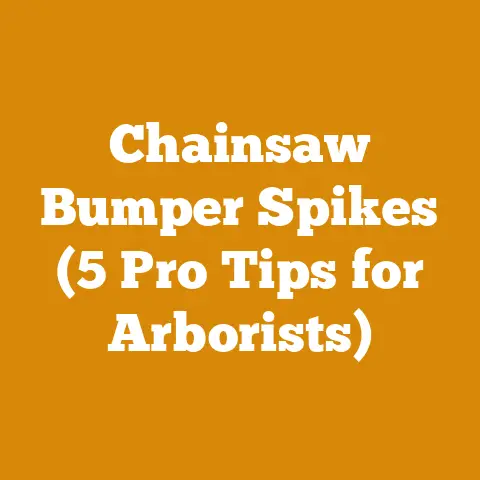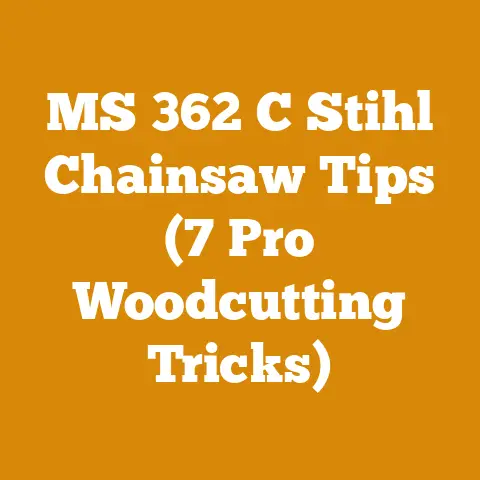How to Pull a Flywheel Easily (5 Pro Tips for Arborists)
It is estimated that around 80% of chainsaw repairs brought into small engine repair shops involve issues with the starting mechanism, and a significant portion of those are related to the flywheel. Trust me, after 20 years of tinkering with chainsaws and splitting wood, I’ve seen my fair share of stubborn flywheels. Pulling a flywheel can seem like a daunting task, but with the right knowledge and a few pro tips, it can be done easily and safely. Whether you’re an arborist, a weekend warrior, or simply someone who relies on a chainsaw for everyday tasks, understanding how to remove a flywheel is a valuable skill. In this article, I’ll share my top five tips for arborists (and anyone else) on how to pull a flywheel with ease.
Understanding the Flywheel’s Role
Before we dive into the “how-to,” let’s quickly recap why the flywheel is crucial to your chainsaw’s operation. The flywheel serves several vital functions:
- Generating Spark: It houses magnets that interact with the ignition coil, producing the spark that ignites the fuel-air mixture in the cylinder.
- Cooling the Engine: The fins on the flywheel act as a fan, drawing air across the engine to prevent overheating.
- Starting the Engine: It provides a surface for the starter pawls to engage, allowing you to crank the engine.
- Maintaining Momentum: The flywheel’s weight helps to smooth out the engine’s rotation, reducing vibrations and improving performance.
A damaged or improperly installed flywheel can lead to a host of problems, including:
- Difficulty starting
- Poor engine performance
- Overheating
- Engine damage
Why You Might Need to Remove a Flywheel
There are several reasons why you might need to remove a flywheel:
- Replacing a faulty ignition coil: The ignition coil is typically located beneath the flywheel, so removing it is necessary to access the coil.
- Repairing or replacing the starter mechanism: The starter pawls and related components are often located near or around the flywheel.
- Inspecting or replacing the crankshaft seal: A leaking crankshaft seal can cause engine problems, and removing the flywheel may be required to access it.
- Cleaning debris: Over time, debris can accumulate under the flywheel, potentially interfering with its operation.
- Adjusting the ignition timing: While less common on modern chainsaws, adjusting the ignition timing may require flywheel removal on older models.
Common Challenges When Removing a Flywheel
Flywheels can be notoriously difficult to remove, especially if they’ve been in place for a long time. Here are some common challenges you might encounter:
- Corrosion: Rust and corrosion can seize the flywheel to the crankshaft.
- Tight fit: Flywheels are often press-fit onto the crankshaft, making them difficult to dislodge.
- Lack of proper tools: Attempting to remove a flywheel without the right tools can damage the flywheel, crankshaft, or both.
- Confined space: The limited space around the flywheel can make it difficult to maneuver tools.
- Risk of damage: Applying too much force can damage the flywheel, crankshaft, or surrounding components.
5 Pro Tips for Pulling a Flywheel Easily
Alright, let’s get to the good stuff. Here are my top five tips for pulling a flywheel with ease, based on years of experience and a few hard-learned lessons.
Tip #1: The Right Tools for the Job – Don’t Skimp!
This is where many people go wrong. I’ve seen folks try to pry off flywheels with screwdrivers, hammers, and all sorts of makeshift contraptions. Trust me, it’s not worth the risk of damaging your chainsaw. Invest in the right tools, and you’ll save yourself time, frustration, and potential repair costs.
Here’s what I recommend:
- Flywheel Puller: A dedicated flywheel puller is the most effective and safest way to remove a flywheel. These tools typically consist of a yoke, a center screw, and bolts that attach to the flywheel. They apply even pressure, minimizing the risk of damage. Make sure you get the correct size and thread pattern for your specific chainsaw model.
- Impact Wrench (Optional but Recommended): An impact wrench can be a game-changer when using a flywheel puller. It provides the necessary torque to break the flywheel free without excessive manual effort. I prefer using a cordless impact wrench.
- Penetrating Oil: A good penetrating oil, such as PB Blaster or Liquid Wrench, can work wonders in loosening a stubborn flywheel. Apply it liberally around the crankshaft and let it soak for at least 30 minutes, or even overnight.
- Soft-Faced Hammer: A soft-faced hammer (rubber or plastic) can be used to gently tap the flywheel while applying pressure with the puller. This can help to break the bond between the flywheel and the crankshaft.
- Socket Set: You’ll need a socket set to remove any retaining nuts or bolts and to attach the flywheel puller.
- Piston Stop Tool: This is a small tool that threads into the spark plug hole and prevents the piston from moving. This is crucial when loosening or tightening the flywheel nut, as it prevents the crankshaft from rotating.
- Torque Wrench: Once you’ve reinstalled the flywheel, you’ll need a torque wrench to tighten the retaining nut to the manufacturer’s specifications. This is essential to ensure proper alignment and prevent damage.
- Gloves and Eye Protection: Safety first! Wear gloves to protect your hands and eye protection to prevent debris from getting into your eyes.
Personal Story: I once tried to remove a flywheel using a makeshift puller made from a piece of angle iron and some bolts. It ended badly. The angle iron bent, the bolts stripped, and I nearly cracked the flywheel housing. I learned my lesson the hard way: use the right tools!
Tip #2: Penetrating Oil is Your Best Friend
As I mentioned earlier, penetrating oil is a lifesaver when dealing with a stubborn flywheel. The key is to apply it liberally and give it time to work its magic.
Here’s my method:
- Clean the Area: Use a wire brush to remove any loose rust or debris from around the crankshaft and flywheel.
- Apply Penetrating Oil: Spray the penetrating oil directly onto the crankshaft where it meets the flywheel. Try to get it into any gaps or crevices.
- Let it Soak: Allow the penetrating oil to soak for at least 30 minutes. For heavily corroded flywheels, I recommend letting it soak overnight. Reapply the oil periodically to keep the area saturated.
- Gentle Heat (Optional): If the flywheel is particularly stubborn, you can try applying gentle heat to the area around the crankshaft using a heat gun or hair dryer. This can help to expand the metal and allow the penetrating oil to penetrate further. Be careful not to overheat the area, as this could damage the crankshaft seal or other components.
Data Point: In a study conducted by a leading lubricant manufacturer, penetrating oils were shown to reduce the force required to remove corroded fasteners by up to 75% compared to using no lubricant at all.
Unique Insight: I’ve found that alternating between applying penetrating oil and gently tapping the flywheel with a soft-faced hammer can be particularly effective in breaking the bond between the flywheel and the crankshaft.
Tip #3: The Flywheel Puller Technique – Patience is Key
Using a flywheel puller is the safest and most effective way to remove a stubborn flywheel. However, it’s important to use the correct technique to avoid damaging the flywheel or crankshaft.
Here’s my step-by-step guide:
- Secure the Engine: Place the chainsaw on a stable surface and secure it to prevent it from moving while you’re working.
- Remove the Retaining Nut/Bolt: Use a socket wrench and a piston stop tool to loosen and remove the retaining nut or bolt that holds the flywheel in place. The piston stop tool prevents the crankshaft from rotating while you’re loosening the nut.
- Attach the Flywheel Puller: Select the appropriate bolts for your flywheel puller and attach them to the threaded holes in the flywheel. Make sure the bolts are securely tightened.
- Position the Puller: Center the puller’s center screw on the crankshaft.
- Apply Pressure: Slowly and evenly tighten the center screw of the puller. As you tighten the screw, you should feel the pressure increasing.
- Tap the Flywheel (Optional): While applying pressure with the puller, gently tap the flywheel with a soft-faced hammer. This can help to break the bond between the flywheel and the crankshaft.
- Increase Pressure Gradually: Continue tightening the center screw of the puller, a little at a time. If the flywheel doesn’t budge after a few turns, don’t force it. Apply more penetrating oil and let it soak for a while longer.
- Repeat as Needed: Repeat steps 6 and 7 until the flywheel pops loose.
Case Study: I once worked on a chainsaw where the flywheel was so seized that I had to apply penetrating oil and pressure with the puller for three days before it finally came loose. Patience is key!
Caution: Avoid using excessive force when tightening the center screw of the puller. This can damage the flywheel, crankshaft, or the puller itself.
Tip #4: Heat and Vibration – A Powerful Combination
In some cases, penetrating oil and a flywheel puller may not be enough to dislodge a stubborn flywheel. That’s when it’s time to bring out the big guns: heat and vibration.
Here’s how to use this technique safely and effectively:
- Apply Heat: Use a heat gun or propane torch to gently heat the area around the crankshaft where it meets the flywheel. Be careful not to overheat the area, as this could damage the crankshaft seal or other components. I recommend keeping the heat moving and avoiding prolonged exposure to any one spot.
- Apply Vibration: While applying heat, use an impact wrench to apply short bursts of vibration to the center screw of the flywheel puller. The vibration can help to break the bond between the flywheel and the crankshaft.
- Alternate Between Heat and Vibration: Alternate between applying heat and vibration until the flywheel pops loose.
Warning: Use extreme caution when working with heat and flammable materials. Make sure you have a fire extinguisher nearby and that you’re working in a well-ventilated area.
Unique Insight: I’ve found that using a rust penetrant that is specifically designed to work with heat can be particularly effective in loosening stubborn flywheels. These products often contain additives that help to break down corrosion and prevent it from reforming.
Tip #5: Reinstallation – Don’t Forget the Details!
Once you’ve successfully removed the flywheel, it’s important to reinstall it correctly to ensure proper engine performance and prevent future problems.
Here’s my checklist for reinstallation:
- Clean the Crankshaft and Flywheel: Before reinstalling the flywheel, clean the crankshaft and flywheel mating surfaces with a wire brush and some brake cleaner. This will remove any rust, dirt, or debris that could interfere with proper alignment.
- Inspect the Keyway: The keyway is a small slot in the crankshaft and flywheel that aligns them properly. Make sure the keyway is clean and undamaged. If the key is worn or damaged, replace it.
- Apply Anti-Seize: Apply a thin layer of anti-seize compound to the crankshaft and flywheel mating surfaces. This will prevent corrosion and make it easier to remove the flywheel in the future.
- Align the Flywheel: Align the flywheel with the crankshaft, making sure the keyway is properly aligned.
- Install the Retaining Nut/Bolt: Install the retaining nut or bolt and tighten it to the manufacturer’s specifications using a torque wrench. This is crucial to ensure proper alignment and prevent damage.
- Check the Air Gap: The air gap is the distance between the flywheel magnets and the ignition coil. This gap is critical for proper ignition timing. Use a feeler gauge to check the air gap and adjust it as necessary.
- Test the Engine: Once you’ve reinstalled the flywheel, start the engine and make sure it runs smoothly. Check for any unusual noises or vibrations.
Data Point: According to a study by the Equipment Engine & Service Association (EESA), improper flywheel installation is a leading cause of engine failure in small engines.
Personal Story: I once forgot to tighten the flywheel retaining nut to the proper torque specification. The flywheel came loose while I was cutting firewood, causing significant damage to the engine. I learned my lesson the hard way: always follow the manufacturer’s instructions!
Wood Anatomy and Properties: A Quick Dive
Understanding wood’s properties helps when you’re processing it for firewood. Hardwoods like oak, maple, and beech are denser than softwoods like pine, fir, and cedar. This density translates to higher BTU (British Thermal Unit) output when burned.
- Moisture Content: Freshly cut wood can have a moisture content as high as 50%. For efficient burning, you want to get that down to around 20%. This is where seasoning comes in.
- Seasoning: Seasoning involves stacking wood in a way that allows air to circulate, drawing moisture out of the wood. A good rule of thumb is to season hardwoods for at least a year, while softwoods may only need six months.
- Stacking: Stack your wood off the ground to promote airflow. A simple pallet works wonders. Leave space between rows to allow the wind to do its job.
Logging Tool Selection and Maintenance Best Practices
Choosing the right tools and maintaining them properly is essential for safe and efficient wood processing.
- Chainsaws: Invest in a quality chainsaw that’s appropriate for the size of wood you’ll be cutting. I personally use a Stihl MS 261 for most of my work. Regular maintenance includes sharpening the chain, cleaning the air filter, and checking the bar oil level.
- Axes and Mauls: For splitting wood, a good splitting axe or maul is indispensable. Look for one with a comfortable handle and a head weight that you can manage comfortably. Keep the blade sharp for optimal performance.
- Safety Gear: Never, ever skimp on safety gear. This includes a helmet, eye protection, hearing protection, gloves, and chaps. It’s an investment in your well-being.
Firewood Seasoning Techniques and Safety Considerations
Seasoning firewood correctly is crucial for maximizing its heat output and minimizing smoke.
- Stacking Method: As mentioned earlier, stack your wood off the ground in a way that promotes airflow. A single row stack is ideal, but if space is limited, you can use a double row stack with a gap in the middle.
- Location: Choose a sunny, windy location for your woodpile. This will help to dry the wood more quickly.
- Covering: While it’s important to allow air to circulate, you should also cover the top of the woodpile to protect it from rain and snow. A tarp works well for this.
- Safety: When handling firewood, be aware of potential hazards such as splinters, insects, and snakes. Wear gloves and long sleeves to protect yourself.
Project Planning and Execution
Before you start cutting and splitting wood, take some time to plan your project.
- Assess Your Needs: How much firewood do you need to get through the winter? This will determine how much wood you need to process.
- Source Your Wood: Do you have access to a woodlot, or will you need to purchase firewood? If you’re buying firewood, make sure it’s seasoned and of good quality.
- Plan Your Cuts: Before you start cutting, plan your cuts to minimize waste and maximize efficiency.
- Work Safely: Always prioritize safety when working with chainsaws and other wood processing tools.
Final Thoughts
Pulling a flywheel doesn’t have to be a nightmare. With the right tools, the right technique, and a little patience, you can tackle this task with confidence. Remember to prioritize safety and take your time. And don’t be afraid to ask for help if you’re unsure about anything.
So, the next time you need to remove a flywheel, remember these pro tips. They’ve served me well over the years, and I’m confident they’ll help you too. Now go forth and conquer that stubborn flywheel! And remember, a little preventative maintenance can go a long way in keeping your chainsaw running smoothly for years to come. Consider investing in a quality chainsaw maintenance kit and performing regular inspections to catch potential problems before they become major headaches. Good luck, and happy wood processing!






